You're using an outdated browser. Please upgrade to a modern browser for the best experience.
Please note this is a comparison between Version 1 by Mohammad Mobarak Hossain and Version 2 by Camila Xu.
Rice cultivation in the low-lying basin-like wetlands, known as the Haor, is often affected by early flash floods during the first two weeks of April. The flooding is mainly caused by heavy rainfall and water surging downstream from the Meghalaya hills in India. This flash flood poses a significant threat to rice production, risking the country’s food security. Dry winter (Boro) rice is the primary food source throughout the year in the Haor region. Flash floods are the most catastrophic, affecting about 80% or even the entire rice yield. In 2017, a loss of 0.88 million metric tons of Boro rice in Haor regions cost the nation USD 450 million.
- flash flood
- low temperature
- cold injury
- Haor
- short duration
- rice
1. Introduction
The low-lying saucer-shaped marshlands are known as the Haor basin (Figure 1). Haor is a unique wetland habitat in the northeastern part of Bangladesh (Figure 2). This country is home to 423 Haors. Haors occupy 0.86 million hectares of land, which is 43% of the total land of the Kishoreganj, Sunamganj, Netrokona, Habiganj, Moulvibazar, Brahmanbaria, and Sylhet districts (Table 1). Sunamganj has the highest number (133) of Haors, while Kishoreganj has the second most (122) followed by Netrokona (80) and Habiganj (38) [1]. The major Haors are the Tanguar, Hakaloki, Shanir, Mokhar, Dekhar, Gongajury, Kaoadighi, etc. The topographic distribution of a Haor is comprised of the high, medium–high, medium–low, low, and very low land types (Figure 3), of which 11% of areas are high to medium–high lands, and 89% areas are low-laying lands [2][3][2,3]. During April–November, the Haor basins experience standing water or sudden floods, while in December–March, they remain dry.

Figure 1.
A conceptual model of
Haor
basin.

Figure 2.
Haor
areas of Bangladesh.
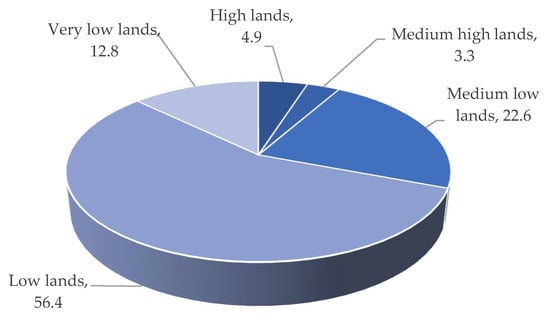
Figure 3.
Topographic distribution of
Hoar
regions.
Table 1.
Number and coverage of
Haor
areas in Bangladesh.
| Districts | Upazilas | Total Land Area (M ha) | No. of Haors | Total Haor Area (M ha) |
|---|---|---|---|---|
|
Nasirnagar and Sadar | 0.19 | 3 | 0.03 |
|
Ajmerigonj, Bahubal, and Sadar | 0.26 | 38 | 0.11 |
|
Austragram, Bazitpur, Bhairab, Itna, Karimgonj, Kuliarchar, Mithamoin, Nikli, and Tarail | 0.27 | 122 | 0.13 |
|
rice acreage, respectively [7]. Kabir et al. [6] also reported that about 36% of the land is under Boro rice cultivation in Sunamganj compared to 23% in Kishoreganj and 11% in Habiganj (Figure 4). Around 22 to 73% of the total land area is under cultivation (Figure 5).
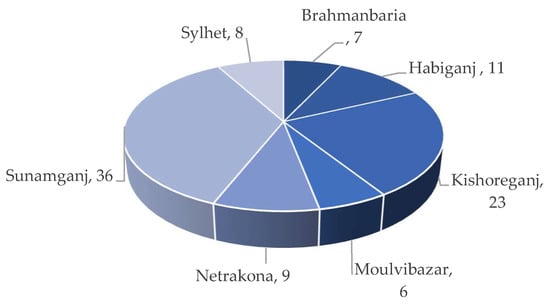
Figure 4.
Percentage of
Boro
areas in the
Haor
districts.
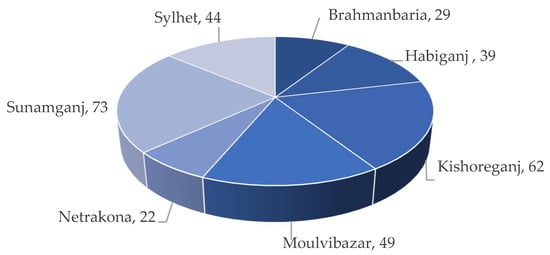
Figure 5.
Percentage of arable land area in the
Haor
districts.
Table 2.
Cultivable land areas of
Hoar
districts.
| Districts | Total Cultivated Land (M ha) |
Cultivated Land under Haor | |
|---|---|---|---|
| M ha | % Area | ||
|
0.15 | ||
| 47.76 | |||
Table 3.
Seasonal coverage (M ha) of diverse crops in the
Haor
regions.
| District | Aus (Summer) Rice | T. Aman (Monsoon) Rice | Boro (Winter) Rice | Other Rabi (Winter) Crops | Cropping Intensity (%) |
|---|---|---|---|---|---|
Table 4.
Boro
acreages in the
Haor
districts and
Haor
regions.
| Districts | Boro Area (M ha) in the | |||||||
|---|---|---|---|---|---|---|---|---|
| District | Haor | |||||||
| 0.01 | 33.77 | |||||||
|
0.111 | 0.032 | ||||||
|
0.120 | 0.046 | ||||||
|
0.167 | 0.103 | ||||||
| 171 | ||||||||
|
0.055 | 0.027 |
|
0.005 | 0.004 | 0.046 | 0.004 | 186 |
|
0.185 | 0.041 |
|
- | - | 0.136 | 0.002 | 143 |
|
0.219 | 0.161 |
|
- | 0.004 | 0.020 | 0.002 | 160 |
|
0.081 | 0.035 | Total | 0.005 | 0.025 | |||
| Total | 0.376 | 0.937 | 0.02 | 0.445 | ||||
Generally, farmers widely cultivate BRRI dhan28 (20% area), BRRI dhan29 (39% area), hybrid varieties (22% area), and other HYVs and local varieties (19% area) of Boro rice (Table 5) as reported by Kamruzzaman and Shaw [4]. It occupies 0.37 M ha, which is >90% of the cultivated land [1], and it accounts for around 16% of the total Boro rice production in the country [5]. It provides a living for 20 million people [8]. In 2022, the area under Boro rice production expanded to 0.45 M ha (Table 4) from 0.37 M ha in 2010 (Table 3). In the Haor areas, the mean yield of HYV Boro rice is about 4.5 t ha−1 compared to 5.8 t ha−1 of hybrid rice (Table 5). The average growth duration of BRRI dhan28 and other hybrid varieties; and BRRI dhan29 are 140 and 160 days, respectively. The typical planting time is 15–20 November, and harvest is on 15 April–15 May. Unfortunately, in the first week of April, just before the harvest, they had severe flash flooding when the water covered all of the immature or almost matured rice [9]. This has resulted in enormous losses for farmers and affects the food security and livelihoods of the Haor families. In April 2017, sudden floods submerged more than 0.20 million hectares of mature, blooming, or dough-stage Boro rice, resulting in 0.90 million ton loss in rice production [10]. Again, in March 2022, about 7,083 hectares of Boro rice went underwater in these regions, causing a loss of around USD 14 million [11].
Table 5.
Area coverage and yield (t ha
−1
) of HYV and Hybrid
Boro
rice in the
Haor
areas.
| Districts | Percent (%) Area | Yield (t ha−1) | ||||
|---|---|---|---|---|---|---|
| BRRI dhan28 | BRRI dhan29 | Hybrid Rice | Other HYV + Local | HYV | Hybrid | |
| ||||||
|
0.19 | 0.04 | 36.53 | |||
| Kulaura, Rajnagar, Sadar, and Sreemangal | ||||||
| 0.28 | 4 | 0.05 | ||||
|
Atpara, Barhatta, Kandua, Khaliajuri, Madan, and Mohongonj | 0.27 | 80 | 0.08 | ||
|
Bishambarpur, Chhatak, Derai, Dharmapasha, Jagannathpur, Jamalganj, Sadar, Salla, and Tahirpur | 0.37 | 133 | 0.27 | ||
|
Balagonj, Beanibazar, Biswanath, Fenchuganj, and Jaintiapur | 0.35 | 43 | 0.19 | ||
| Total | 2.00 | 423 | 0.86 | |||
Boro rice, cultivated under irrigated conditions from mid-November to mid-May (Rabi season), is the primary source of income for Haor families. Most land remains submerged throughout the monsoon season, fostering a productive fishery. According to Alam et al., a total of 0.41 M ha of cultivable land is available in the seven Haor districts (Table 2), which is about 48% of the Haor areas [1][4][1,4]. The Boro rice–Fallow–Fallow is the primary cropping pattern of the Haor areas. However, some Aus (summer) and T. Aman (monsoon) rice is also grown very small in the Haors of Habiganj, Netrakona, Moulvibazar, and Sylhet [1]. The average cropping intensity of Haor areas is 176% (Table 3) as reported by the DAE [3]. Haor regions play a crucial role by (i) contributing around 18% of the overall Boro rice production [5] and (ii) generating job opportunities for non-farm wage employees by harvesting Boro rice about one month before other locations [6]. Data presented in the Table 4 shows that Haor districts and regions account for around 19% and 9% of the nation’s total Boro
| |||||||||||||||||
|
0.17 | 0.12 | 89.59 | ||||||||||||||
| - | - | 0.014 | 0.003 | 189 | |||||||||||||
| 27 | 40 | 15 | 18 | 4.85 | 5.92 |
|
|||||||||||
|
14 | 52 | 24 | 10 | 4.93 | 5.45 |
|
0.20 | 0.14 | 52.14 | |||||||
| - | 0.010 | 0.033 | 0.001 | 171 | |||||||||||||
|
|||||||||||||||||
| - |
| - | 0.117 | 0.007 |
| 215 | 12 | 49 | 20 | 18 | 4.37 | 5.82 | 0.13 | ||||
|
| ||||||||||||||||
| 0.02 |
| 42.02 | ||||||||||||||
| - | 0.007 | 0.010 | 28 | 27 | 200.001 | 25 | 4.10 | 5.78 |
|
Haor wetlands of the country [16][17]. For instance, the flash flood in 2017 caused a loss of 0.88 million metric tons of Boro rice in the Haor districts [17][18]. The monetary value of rice production loss was estimated at USD 450 million. Assuming a 33% probability of flash floods occurring in the Haor areas (once in three years), the economic value of rice production loss is estimated at USD 150 million per year. As a result, sustaining a safe production system in rice-based Haor agricultural regions is becoming difficult due to flash floods, and it is also a formative example of the problems associated with achieving sustainability in agriculture [18][19].

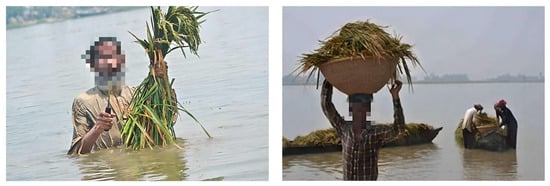 Flash flood hits by the 3rd or 4th week of March, known as Chaitali Dhall, induce irreversible destruction to the immature/almost matured Boro rice [15][13]. An early flash flood or flash flood does not occur every year. In March 2017 and 2022, a devastating flash flood occurred unexpectedly, and the flooding of immature Boro rice produced a devastating catastrophe [10][11][10,11]. According to meteorological data analysis, from 1955 to 2022, early flash floods have occurred in the Haor area in 1964, 1982, 1996, 2003, 2010, 2017, and 2022 (Figure 9). The Haor regions of Bangladesh, located downstream of India’s Cherapunji area, are prone to annual flash flooding. Five or six days of precipitation over 150 mm can cause floods in the Haor basin and its tributaries [9]. Since 1955, the rainfall in the Haor areas from 20 March to 15 April has exceeded 150–200 mm in 1964, 1982, 1996, 2003, 2010, 2017 and 2022 (Figure 9). In 1964, 1982, 2003, and 2010, it was 186, 216, 184 and 296 mm, respectively. In comparison, rainfall in 2017 and 2022 was 627 and 356 mm, respectively (Figure 9). The precipitation in 2010 and 2022 may be characterized as more intense, but in 2017, it was overwhelming [19][20]. Observations indicate that these exceptional rainfalls occurred every seven years up to 2017. Still, in 2022, it was two years earlier, even though the Meteorological Department of Bangladesh projected an increase in the incidence of early flash floods. In the years to come, the frequency of early flash floods may increase due to global climate change.
Flash flood hits by the 3rd or 4th week of March, known as Chaitali Dhall, induce irreversible destruction to the immature/almost matured Boro rice [15][13]. An early flash flood or flash flood does not occur every year. In March 2017 and 2022, a devastating flash flood occurred unexpectedly, and the flooding of immature Boro rice produced a devastating catastrophe [10][11][10,11]. According to meteorological data analysis, from 1955 to 2022, early flash floods have occurred in the Haor area in 1964, 1982, 1996, 2003, 2010, 2017, and 2022 (Figure 9). The Haor regions of Bangladesh, located downstream of India’s Cherapunji area, are prone to annual flash flooding. Five or six days of precipitation over 150 mm can cause floods in the Haor basin and its tributaries [9]. Since 1955, the rainfall in the Haor areas from 20 March to 15 April has exceeded 150–200 mm in 1964, 1982, 1996, 2003, 2010, 2017 and 2022 (Figure 9). In 1964, 1982, 2003, and 2010, it was 186, 216, 184 and 296 mm, respectively. In comparison, rainfall in 2017 and 2022 was 627 and 356 mm, respectively (Figure 9). The precipitation in 2010 and 2022 may be characterized as more intense, but in 2017, it was overwhelming [19][20]. Observations indicate that these exceptional rainfalls occurred every seven years up to 2017. Still, in 2022, it was two years earlier, even though the Meteorological Department of Bangladesh projected an increase in the incidence of early flash floods. In the years to come, the frequency of early flash floods may increase due to global climate change.
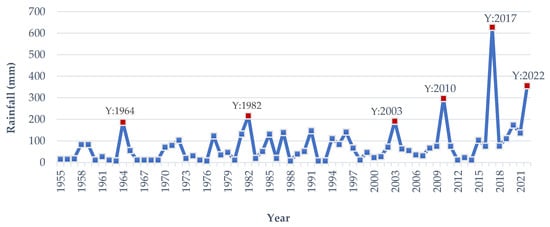 Boro rice must be harvested before the end of March to prevent early flash floods. The crops will then be protected from early flash floods. This variety’s growth period must be 135–140 days while planted at the standard time. A variety with such accommodating growth time is currently unavailable. The BRRI dhan28 is the most popular mega rice variety in the Haor region due to its high yield and shorter growth duration. The average growth duration of this variety is about 140 days under the recommended cultivation procedure. Farmers cultivate this variety at the medium–low land to low land areas of the Haor. BRRI released rice varieties viz., BRRI dhan35, 36, 45, 67, 84, 88, BRRI hybrid dhan3, and 5 are the coeval of BRRI dhan28 [14][16]. These short-duration varieties would not survive the early flash floods because they can be harvested by 10 April if 30-day-old seedlings are transplanted on 15 November at the regular time (Figure 10). Suppose these varieties are sown earlier, for example, on 15 October and even 1 November. In that case, they could be harvested by 28 March and 4 April, respectively, but will be in cold injury at the reproductive phase (Table 6).
Boro rice must be harvested before the end of March to prevent early flash floods. The crops will then be protected from early flash floods. This variety’s growth period must be 135–140 days while planted at the standard time. A variety with such accommodating growth time is currently unavailable. The BRRI dhan28 is the most popular mega rice variety in the Haor region due to its high yield and shorter growth duration. The average growth duration of this variety is about 140 days under the recommended cultivation procedure. Farmers cultivate this variety at the medium–low land to low land areas of the Haor. BRRI released rice varieties viz., BRRI dhan35, 36, 45, 67, 84, 88, BRRI hybrid dhan3, and 5 are the coeval of BRRI dhan28 [14][16]. These short-duration varieties would not survive the early flash floods because they can be harvested by 10 April if 30-day-old seedlings are transplanted on 15 November at the regular time (Figure 10). Suppose these varieties are sown earlier, for example, on 15 October and even 1 November. In that case, they could be harvested by 28 March and 4 April, respectively, but will be in cold injury at the reproductive phase (Table 6).
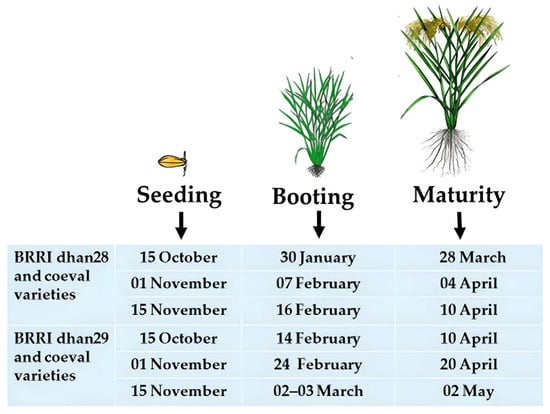
In a series of cold-tolerance nurseries in Australia, the cold-tolerant rice variety Sherpa exhibited superior spikelet fertility compared to the standard checks. Furthermore, its spikelet fertility was comparable to that of the cold-tolerant standard Chinese variety Baijieming and Japanese variety Jyoudeki [59][60]. The Quest has also exhibited moderate cold tolerance in Australia [69][70]. According to Ghimiray and Gurung, Barkat, a cold-tolerant variety cultivated in the mid-altitude valleys of Bhutan attains maturity early [70][71]. The feasibility of utilizing the Bhutanese rice variety Kuchum to develop a cold-tolerant variety was documented by Endo et al. [71][72]. Additionally, Yusi Rey Maap1, Yusi Rey Kaap2, and Jakar Rey Naab are cold-tolerant varieties indigenous to Bhutan [50][51].
The lofty mountains of Nepal are crucial for the development of a cold-tolerant rice genome. In Chhumchaur, Jumla, Nepal, the renowned Jumli Marsi variety is cultivated at an astounding elevation of 3000 m above sea level (ASL). According to Gautam and Shrestha [55][56], Chhomrong dhan, Machhapuchre-3, and Palung-2 have been introduced for the mild-temperate high hill regions of Nepal (1300–2000 m ASL), whereas Chandannath-1 and Chandannath-3 have been designated for the Jumla valley (2300 m ASL) [15][13]. However, several cold-tolerant rice varieties viz., Manjushree 2, Tainan-1, Chainan-2, Chainung-242, Taichung-176, Himali, Kanchan, Khumal-2, Khumal-3, Khumal-4, Khumal-5, Khumal-6, Khumal-7, Khumal-8, Khumal-9, and Khumal-9 have been released for mild temperate regions of Nepal. According to a study by Karki et al., farmers in Nepal have thus far embraced Chhomrong, Machhapuchre-3, Chandannath-1, Chandannath-3, and Palung-2 as cultivars that tolerate cold conditions. The Chhomrong variety has become the most significant variety in Madagascar and Bhutan [75][76].
The study conducted by Neelima et al. in Telangana, India, observed that the cold-tolerant varieties Akshaydhan, Taramati, Bhadrakali, RNR 18805, RNR 17813, and WGL 44 performed better over the other cold tolerant varieties viz., Sheetal, Tellahamsa, and JGL 3844 [54][55]. Moreover, HPU1, Kanchan, Himali, Himdhan, Himalaya1, K332, Kalimpong1, Khonorullo, and Meghalaya1 are typical cold-tolerant rice varieties cultivated at high altitudes in India and Nepal [69][70].
Again, Basuchaudhuri reported that certain cultivars originating from China (B55, Banjiemang, Lijiangheigu, and Yunlu 29), Hungary (HSC55), Japan (Jyoudeki), and the United States (M103 and M104) exhibited low-temperature tolerance or a moderate degree of tolerance during the booting and flowering phases [69][70]. At all growth stages, three Chinese varieties and one Hungarian variety exhibited consistent resistance to cold temperatures. The TR22183, a temperate japonica variety originating in northern China, exhibits exceptional resistance to low temperatures [72][73]. In the Tohoku region of Japan, there are notable cultivars of cold-tolerant rice—namely, Hitomebore, Ouu 415, Tohoku PL 3, Iwate 100, and Tohoku 207 [58][59]. Regarding grain fertility, Wang et al. documented that Jinbubyeo, Junganbyeo, SR30084-F8-156, IR83222-F8-156, and IR83222-F8-14 from Korea, and Kuban-3 and Severny from Russia exhibited cold tolerance against cold susceptible commercial rice cultivars [74][75]. After careful evaluation, these genotypes might be collected and included in the Bangladesh rice breeding package to make cold-tolerant cultivars. The development of cold-tolerant Boro rice varieties utilizing cutting-edge breeding approaches is the most appropriate solution to overcome flash food and cold injury in the Haor region of the country.
The evaluation of antioxidant enzyme activities could both identify cold-tolerant plants and elucidate the mechanisms underlying cold tolerance as opposed to relying solely on physical assessment of whole-plant cold tolerance. As illustrated by Kim and Tai, temperate varieties of O. japonica demonstrate reduced levels of electrolyte leakage (EL), whereas O. indica varieties accumulate greater quantities of proline, malondialdehyde (MDA), ascorbic acid (AsA), and glutathione (GSH) [67][68]. Cold tolerance in rice can also be determined by analyzing the activities of antioxidant enzymes, including superoxide dismutase, catalase, and ascorbate peroxidase [85][107][86,108]. Enhanced levels of OsPOX1, APXa, and the associated kinase OsTrx23 have been observed to potentially regulate the expression of numerous genes in response to cold stress [79][81][108][80,82,109].


Figure 8.
Flash flooding caused damage to
Boro
rice in the
Haor
areas.

Figure 9.
The average rainfall in
Haor
regions was from 20 March to 15 April from 1955 to 2022. Y: Year.

Figure 10.
Effect of seeding dates on the maturity time of
Boro
rice in the
Haor
areas.
Table 6.
Different planting dates of different
Boro
rice varieties of Bangladesh and associated risks in the
Haor
regions.
| Rice Varieties | Seeding by | Transplanting by | Panicle Initiation by | Heading by | Harvesting by | Risks |
|---|---|---|---|---|---|---|
|
15 October | 15 November | 15 January | 15 February | 21 March | Spikelet sterility |
| 1 November | 7 December | 1st week of February | 7 March | 7 April | Spikelet sterility Early flash floods |
|
| 15 November | 15 December | 21 February | 15 March | 15 April | Flash floods | |
|
15 October | 30 November |
6.2. Breeding of Cold-Tolerant Rice
6.2.1. Physiological Basis of Cold Tolerance
Cold temperatures cause physiological fluctuations that appear as physical damage in the field or laboratory. Physiological fluctuations have been categorized into six categories related to (i) amino acids, (ii) antioxidants, (iii) chlorophyll concentration and fluorescence ratio, (iv) electrolyte leakage, (v) ROS and MDA, and (v). soluble sugars. Changes in concentrations of these metabolites may indicate cold-stress reactions in rice [20][21]. The accumulation of amino acids, e.g., proline, is accelerated by cold stress. Proline serves as a cellular enzyme denaturation inhibitory agent and a C and N reservoir [76][77]. Protein synthesis is sustained due to the stabilizing effect of this amino acid [77][78]. It is also involved in the removal of excess H+ caused by stress and in maintaining the optimal cytosolic pH for oxidative respiration. Furthermore, it enhances the water-binding capacity of proteins [78][79]. Kim and Tai have confirmed the correlations between proline accumulation and cold tolerance in rice [67][68]. Antioxidants namely, ascorbic acid (AsA) and glutathione (GSH), scavenge ROS as an additional metabolic adaptation to safeguard rice plants from oxidative harm caused by cold stress [67][79][68,80]. They are present in chloroplasts and other cellular compartments in high concentrations; they are essential for plant defense against oxidative stress [80][81]. According to Sato et al., cold tolerance can be enhanced through the upregulation of OsAPXa, an ascorbate peroxidase gene, which elevates ascorbate peroxidase activity and decreases lipid peroxidation and H2O2 levels in response to cold stress [81][82]. The chlorophyll concentration and fluorescence ratio are important photosynthetic parameters affecting plant cold responses. According to Haboudane et al., chlorophyll levels may indicate nutritional stress, particularly N or S stress [82][83]. Cold stress may hinder rice leaf chlorophyll production and chloroplast development. Reduced chlorophyll concentration in rice plants may reflect the impact of low temperatures [83][84]. Cold stress causes a minor drop in fluorescence ratio values in tolerant plants but a large decrease in sensitive plants [84][85][85,86]. This metric helps assess plants’ cold tolerance and sensitivity, which may vary due to genetics or acclimatization. Alterations in membrane rigidity, the physical state of membrane proteins, and osmotic pressure enable rice cells to detect cold stress [86][87]. Elevated membrane rigidity is initiated by low temperatures, which may result in elevated electrolyte leakage, and indicates the activity of genes associated with cold tolerance, such as TERF2, OVP1, and OsNAC5 [87][88][88,89]. An early occurrence cold stress, the influx of Ca2+ into the cytoplasm, may be facilitated by Ca2+ channels stimulated by ligands, membrane rigidification, or mechanical stimuli [89][90]. The calcium signaling cascade interprets and amplifies this cold-sensing signal, which then activates the dehydration-responsive element pathway in rice. This pathway is crucial for rice cold sensing and response [20][90][21,91]. Reactive oxygen species (ROS) are oxygen-containing molecules that are generated in trace amounts as typical by-products of cellular metabolism within chloroplasts, mitochondria, and peroxisomes [20][21]. Cellular oxidative injury can occur when an inordinate amount of ROS is produced [91][92][92,93]. The ROS may impede CO2 fixation, restrict electron transport chain mitochondria, and disrupt the photosynthetic process in chloroplasts [93][94]. It also degrades polyunsaturated lipids to produce malondialdehyde (MDA), which induces cellular toxic stress, tissue injury, and cellular dysfunction [94][95]. Additional research has demonstrated that the accumulation of ROS within the cells of rice that has been cold-treated induces the activation of cold-responsive genes and controls the cold-responsive signaling network [95][96]. Soluble sugars, viz., glucose, fructose, hexose, raffinose, sucrose, and trehalose function as compatible solutes and osmoprotectants against chilling-dehydration injury under cold stress [96][97][97,98]. Again, stachyose, raffinose, sucrose, and trehalose can increase in concentration when exposed to low temperatures [98][99]; thus, they can serve as indicators for assessing the potential cold tolerance of rice.6.2.2. Assessment of Cold Tolerance in Rice
In all stages, cold temperatures have a negative impact, but the booting stage is more detrimental. There are distinct criteria for evaluating cold tolerance in rice [20][21]. The seedling to reproductive phases is the primary time when rice cultivars with increased cold tolerance are evaluated. Germination phase cold tolerance is essential for rapid seedling establishment and uniform crop stand [99][100]. The evaluation of cold tolerance in seedlings is vital for adaptation to situations with chilly temperatures that may occur at night-time, the beginning or end of the growing season. To produce the most grain, the survival of pollen, seed germination, and seedling establishment all require cold tolerance [100][101]. Table 9 summarizes the evaluation criteria for cold tolerance in rice at various phases of development [20][21].Table 9.
Criteria for evaluating the cold tolerance of rice at various development stages.
| Criteria in Different Stages | Indicators | Temperature and Duration | References | |
|---|---|---|---|---|
| Treatment | Recovery | |||
|
||||
|
The ratio of sprouted seeds to the total number of seeds used | 14 °C for 7–17 days | - | Han et al. [101][102] |
|
The ratio of survived seedlings over the total number of sprouted seeds | 2 °C for 72 h | 20 °C for 7 days | Zhou et al. [102][103] |
|
||||
|
Changes in fresh weight of plants after cold treatment | 10 °C for 1–48 h | - | Bonnecarrère [85][86] |
6.2.3. Molecular Basis of Cold Tolerance
Several genes control the quantitative property of rice cold tolerance. Due to the difficulties in directly linking plant phenotypes to the genes that govern cold tolerance, marker-assisted selection is a helpful technique for creating cold-tolerant cultivars [106][109][107,110]. Rice cold tolerance has been linked to specific QTL using molecular markers and linkage maps. Studies of the QTLs associated with cold tolerance from germination to reproductive phases [20][21] could be helpful to speed up rice breeding for cold tolerance (Table 10), which could be utilized for developing cold-tolerant rice varieties for the Haor areas of Bangladesh.Table 10.
QTLs linked to rice’s cold tolerance.
| Name of QTL | Trait for Mapping | Chromosome No. | Reference | |||||||
|---|---|---|---|---|---|---|---|---|---|---|
| Ctb1, Ctb2 | Seed fertility | 4 | Saito et al. [46][47] | |||||||
| Dth, cl, fer, pe, dc | Days to flowering, culm length, seed fertility, and panicle exertion | 1, 3, 5, 6, 7, 8, 9, 11 | Oh et al. [110][111] | |||||||
| Os01g0357800, Os05g0171300, Os05g0400200 | Seedling vigor | 1, 4, 5 | Ham et al. [111][112] | |||||||
| 15 February | 7 March | 7 April | Early/flash floods | |||||||
|
0.21 | |||||||||
| 0.05 | 63.02 | ||||||||
| 20 | 40 | 18 | 20 | 5.07 | 6.72 |
| ||||
|
15 | 43 | 22 | 20 | 4.30 | 5.50 | 0.21 | 0.03 | 15.80 | |
|
21 | 22 | 31 | 24 | 4.33 | 5.65 | Total | 1.26 | 0.41 | |
| Average | ||||||||||
| 19.6 | ||||||||||
| 39.0 | 21.4 | 19.3 | 4.56 | 5.83 |
Rice breeders, agronomists, and researchers have been suggesting farmers seed Boro rice earlier than usual during the last week of October that could be harvested in March to reduce the risks of flash flooding. However, this runs the risk of rice plants experiencing cold shock between mid-February and mid-March at rice’s reproductive stages (panicle initiation through blooming). The grains of early-planted Boro rice become sterile when the mean temperature remains under 20 °C for one week [12]. Hence, cultivating short-duration Boro rice varieties of 135–140 days and medium duration of 141–150 days with modest adaptation to cold during the reproduction phase is a significant thrust to avoid flash floods while being planted in the last week of October to mid-November. Therefore, for the Haor regions, rice varieties that are cold tolerant to the reproductive phase should be developed and have a short to medium lifespan that could be harvested before the arrival of flash floods.
2. Flash Floods and Cold Risks of Damage to Boro Rice in the Haor Regions
Three different types of flooding impact the Haor regions: (i) early flash floods, (ii) rainfed floods, and (iii) river floods. The flash/early flash flood had a devastating impact on Haor [3]. According to BBS [13][15], from 1955 to 2022, this form of flood occurred 70% of the time, which was followed by rainfed floods (19%) and river floods (11%) (Figure 6). Overall, 90% to 100% of low and medium-low land regions are inundated by flash/early flash floods, while only 6 to 13% of medium-high and high-land areas are affected (Figure 7). That damaged 97% of Boro rice and 3% of other Rabi (winter) crops like mustard, ground nut, winter vegetables, etc. The cultivation of Aus (summer) and T. Aman (monsoon) rice is unaffected (if grown) [1][2][4][1,2,4].
Figure 6.
Types of floods that cause crop damage.
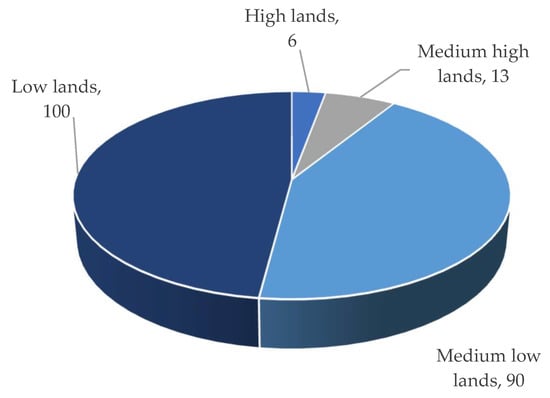
Figure 7.
The type of land most affected by flash/early flash flooding.
| 1 November | |||||
| 15 December | |||||
| 28 February | 22 March | 22 April | Early/flash floods | ||
| 15 November | 30 December | 7 March | 7 April | 30 April–7 May | Early/flash floods |
3. Temperature Requirements for Rice Plant
Regular (15 November) planting of Boro rice in Haor locations does not result in cold harm during the reproductive stage, but flash flood damage is probable at harvest [9]. To avoid this disaster, early transplanted Boro rice has been suggested. However, there is a possibility that low temperatures will be encountered during the particular phases of rice establishment (Figure 11). Since rice is a thermophilic plant native to tropical and subtropical environments [20][21], it has a definite temperature requirement. The ideal range of temperatures for cultivating the Indica variant is 25–35 °C, and for the Japonica variant, it is 20–33 °C [21][22]. The critical low temperature is often believed to be below 20 °C. It varies from one phase to the next in rice development (Table 7) as stated by Yoshida [21][22]. However, it varies by variety, length of critical temperature, growth circumstances, and daily fluctuations [22][23]. Yoshida [21][22] demonstrated that 10–13 °C is the lower temperature limit for rice plants that induce cold damage during the seed germination and vegetative phases. The threshold temperature falls between 18 and 20 °C at the reproductive stage and below 20 °C during the development of pollen mother cells, frequently producing a significant proportion of sterile spikelets. The germination and seedling development occur best at 25–35 °C [23][24]. At the booting stage, the threshold temperatures for cold-sensitive and cold-tolerant rice are 20 and 15 °C, respectively [24][25]. Spikelet sterility occurs when the temperature goes below this critical limit for three consecutive days. However, the harm is catastrophic if the condition lingers for five to six days [14][16]. The critical night-time temperature ranges from 13 to 15 °C during the reproductive period and is capable of causing cold damage [22][23]. Reports show that 12–13 °C night and 28–29 °C day temperatures are essential during the reproductive stage since these temperatures reduce rice output by 50% compared to its initial level [9].
Figure 11.
Effect of cold temperature on different growth phases of
Boro
rice.
Table 7.
Temperature (°C) requirements at different growth phases of rice plants.
| Rice Growth Phases | Optimum | Minimum | Maximum |
|---|---|---|---|
|
20–35 | 10 | 45 |
|
25–30 | 12–13 | 35 |
|
25–28 | 16 | 35 |
|
31 | 7–12 | 45 |
|
25–31 | 9–16 | 33 |
|
30–33 | 22 | 35 |
|
20–25 | 12–18 | 30 |
3.1. Influence of Cold Temperature on the Vegetative Growth of Rice
Every developmental phase of rice, from vegetative to reproductive (Table 7), including germination, seedling, tillering, blooming, grain filling, and maturity, is influenced by cold temperature [25][26][27][26,27,28]. Common signs of cold temperature damage during the germination stage include a terrible delay in germination and a lower germination rate [28][29][30][29,30,31]. Low temperature affects seedling vigor and development [31][32][32,33], decreases the seedling quantity and tillering [33][34], increases plant mortality [23][34][24,35], and lengthens the growth time [35][36]. At the vegetative stage, cold injury in rice emerges: (i) leaves turn yellow, (ii) tiller number is reduced, (iii) plant height is impeded, (iv) biomass synthesis decreases, and (v) growth duration lengthens [36][37].3.2. Influence of Cold Temperature on the Reproductive Growth of Rice
3.2.1. Floral Organs Development
During the reproductive phase, cold temperature inhibits anthers development, viz., the disappearance of anthers, little or no bursting of the anther, immature pollens, and few or no pollen shedding. Thus, pollen cannot germinate [21][37][38][22,38,39]. Panicle initiation is heavily controlled by temperature since rice must accrue a particular number of degrees days before the commencement of the reproductive stage [39][40]. Research suggests that 1–2 weeks before heading, the booting time, is especially vulnerable to cold. Flowering and heading are also susceptible to low temperatures [21][22]. Cold stress also causes late flowering, partial panicle exertion, and the deformation of spikelets [27][40][28,41]. However, spikelet sterility is the most prevalent damage caused by pollen aborting [37][41][42][38,42,43]. Young microspores are particularly vulnerable to the chilling injury that causes male sterility [43][44]. Temperatures as low as 12 °C for six days create almost complete sterility [21][22]. Under cold stress, inferior spikelets and a delay in blooming result in poor grain growth and reduced grain production associated with a deficiency of carbohydrates [36][44][37,45].3.2.2. Grain Formation and Development
During the growth of rice grains, low temperature causes incomplete and delayed maturation, and grain development is regulated by a source–sink relationship that is affected by low temperature [45][46]. Grain filling duration and rate are reduced under cold stress, resulting in smaller grain sizes [46][47]. Moreover, hormones in plants, viz., abscisic acid (ABA) and cytokinin (CKT), also impact rice grain development [45][47][46,48]. Under cold stress, ABA and CKT concentrations increase and function as stress regulators in rice. Due to a lack of carbon dioxide (CO2) within cells, stomatal closure occurs at elevated ABA levels in leaves, hence restricting photosynthesis. Cold stress decreases the grain filling duration and rate, reducing rice grain yield. Somersalo and Krause [48][49] also showed that cold temperatures restrict photosynthesis, negatively affecting grain production and quality since there is less accessible glucose for grain production. Other studies have shown that low temperatures result in grain’s partial and late maturity [27][49][28,50].4. Global Scenario of Cold Damage in Rice
In many Asian countries, rice is especially susceptible to cold stress and has been extensively reported in Bhutan, China, India, Japan, Korea, and Nepal [40][49][41,50]. In Bhutan’s upper altitudes, throughout the seedling development in March–April and maturation between October and November, air temperatures persist below 15 °C, rendering rice cultivars extremely susceptible to cold harm [50][51]. In case of delayed transplanting, rice suffers cold damage during the blooming and ripening periods in October and November, resulting in the sterility of the spikelets [48][49]. In southern China, early-planted rice suffers severely from frost damage, mainly between February and March, during the seedling stage, while late-planted rice suffers from cold injury in the reproductive phase (October–November) in northeast, east, and southwest China [51][52][52,53]. The average temperature in the Telangana state, India, ranges between 8 and 13 °C from December to 15 February, representing a substantial abiotic constraint for rice cultivation [53][54][54,55]. The cold damage is the greatest constraint for rice in the temperate zone of Nepal (1000–2000 m above sea level). Reports found that yield loss is moderately severe due to high levels of sterility and panicle degeneration at 1300 m above sea level when the temperature drops below 20 °C [55][56][56,57]. Low temperatures caused severe damage to Korean rice at every stage, between seed sprouting and maturity, in all rice-growing regions [57][58]. In Japan, the air temperature drops below the critical point during September and October, when rice is in the flowering or maturation phases [58][59]. The winter season in Australia (late January–early February) impedes the development of pollen grains and results in the sterility of spikelets [59][60][60,61]. Rice must also be cold-tolerant, since the cold stress frequently threatens the yield in Africa, Europe, South America, and the United States [36][37].5. Rice Cold-Stress Problem in Bangladesh
Cold damage during the dry season of Boro rice is a countrywide issue in many locations, including the Haor districts of Bangladesh [14][16]. The meteorological data of the World Bank [19][20] reported that, during the Bangladesh’s Boro season, the air temperature drops below the essential temperature for rice, particularly in the country’s north (Figure 12 and Figure 13). Boro rice seedlings faced exceptionally low temperatures in December. Seed germination rates became poor in several circumstances. With insufficient development, the seedling became yellowish. Farmers were unhappy with their rice seedlings since they did not receive excellent seedlings from their seed beds. Following transplantation, seedling mortality occurred. Transplantation was occasionally delayed by two weeks. Some farmers must purchase seedlings from the market at a significant cost [14][16]. The BRRI suggests sowing short and long-duration rice during 15–30 and 5–25 November, respectively. Due to the early receding of floodwaters, farmers in some Haor regions may be unable to adhere to the approved planting timetable, since they must use the residual floodwater for seedling growing and crop establishment. To prevent the flash flood, short-duration cultivars are typically advised for early sowing (from late October to early November) in a Haor region, which may expose the rice crop to low temperatures during the transition from the vegetative to reproductive development stages. Even early planting of a long-duration cultivar may be susceptible to cold damage during its reproductive phase [9]. As an example, for short-duration rice (135–140 days) sown on 15 October, the most sensitive stage, panicle initiation (PI), and flowering/anthesis occur during the second week of January and the second week of February, respectively (Table 6). These dates are shifted to the 1st week of February and 1st week of March when seeded on 1 November. Seedings seeded on 15 October have a 100% probability of suffering from cold injury, while the probability is 60% for 1 November seedings [12] because the mean air temperature from January to mid-February remains 15–20 °C in the Haor areas (Figure 12). However, January is the coldest month in Bangladesh followed by December and February (Figure 13).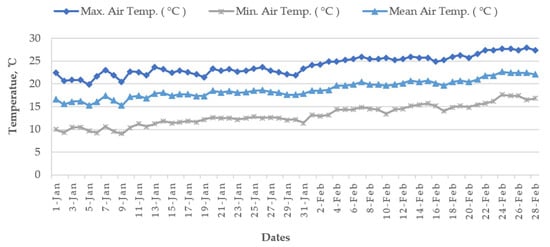
Figure 12.
Average air temperature of January–February from 1955 to 2022 at the seven
Haor
districts of Bangladesh.
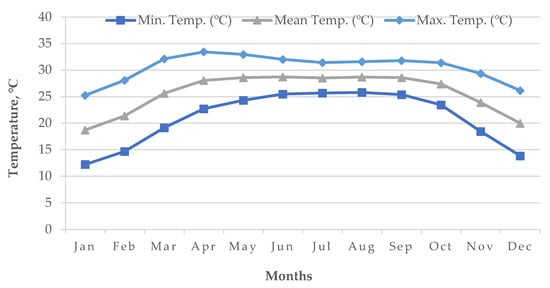
Figure 13.
Average air temperature (1955–2022) of Bangladesh.
6. Alleviation of Flash Flood and Cold Injury Damage of Boro Rice in the Haor Areas
6.1. Cultivation of Appropriate Boro Rice Varieties
Cultivating short-duration and cold-tolerant cultivars is the ultimate response to rice flash flooding and cold damage in the Haor regions of Bangladesh. However, Bangladesh currently lacks such suitable cultivars. New cold-tolerant short-duration (135–140 days) and medium-duration (141–150 days) cultivars should be developed. Farmers must sow seeds between 25 October and 1 November and transplant seedlings when they are 30–35 days old so they can be harvested by the end of March (Figure 14). If seeds are seeded during this time, the booting and heading period will inevitably fall into the cold current (Figure 12). Hence, cultivating cold-tolerant rice that can withstand <20 °C temperature during the reproductive phase could be the best alternative Boro rice for the Haor areas of Bangladesh.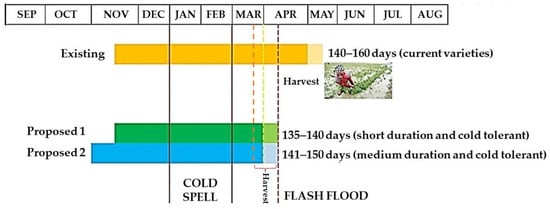
Figure 14.
Existing and proposed planting schedule of
Boro
rice for the
Haor
areas.
Table 8.
Available cold-tolerant rice genotypes in various countries.
| Country | Rice Varieties/Genotypes | References | ||||||
|---|---|---|---|---|---|---|---|---|
| Australia | Sherpa, Quest | Basuchaudhuri [69][70] Reinke et al. [59][60] |
||||||
| Bhutan | Barkat, Chhomrong dhan, Jakar Rey Naab, Khangma Maap, Kuchum, Yusi Rey Kaap1, Yusi Rey Kaap2, Yusi Rey Maap1, Yusi Rey Maap2 | Ghimiray and Gurung [70][71], Endo et al. [71][72] | ||||||
| China | B55, Banjiemang, Daohuaxiang2, KY131, Lijiangheigu, Longgeng31,TR22183, Yunlu 29 | Basuchaudhuri [69][70], Jiang et al. [72][73], and Li et al. [73][74] |
||||||
| Hungary | ||||||||
| qCTB-1-1 | HSC55 | , −4-1/2, −5-1/2, −10-1/2, −11-1Basuchaudhuri [69][70] | ||||||
| Seed fertility | 1, 4, 5, 10, 11 | India | Akshaydhan, Bhadrakali, Himalaya1, Himali, Himdhan, HPU1, JGL 3844, K332, Kalimpong1, Kanchan, Khonorullo, Meghalaya, RNR 17813, RNR 18805, Sheetal, Taramati, Tellahamsa, WGL 44 | Neelima et al. [54][55] Basuchaudhuri [69][70] |
||||
| Xu et al. | [ | 26 | ][27] | |||||
| qCTB2a, qCTB3 | Seed fertility | 2, 3 | Andaya and Mackill [25][26] | Japan |
|
|
||
| The ratio of live plants to the plants treated | 4 °C for 6 days | |||||||
| qCTB-5-1/2/3, −7 | 26 °C for 6 days | Seed germination | 5, 7 | Lin et al. [112][113]Zhang et al. [88][89] | ||||
| Korea |
|
Wang et al. [74][75] | ||||||
| qCTP11, qCTP12 | The emergence of new leaves | 4 °C for 7 days | 25 °C for 10 days | Seed germination | 11, 12 | Baruah et al. [34][35]Xie et al. [79][80] | Nepal | Chainan-2, Chainung-242, Chandannath-1, Chandannath-3, Chhomrong dhan, Himali, Jumli Marsi, Kanchan, Khumal-2, Khumal-3, Khumal-4, Khumal-5, Khumal-6, Khumal-7, Khumal-8, Khumal-9 Machhapuchre-3, Machhapuchre-3, Manjushree 2, Palung-2, Taichung-176, Tainan-1 |
| Gautam and Shrestha | [55][56 | Visual scoring of 1: dark green, 3: light green, 5: yellow, 7: brown, 9: dead] |
9 °C for 8–14 days | - | |||
| qCTS12, qCTS12a | Karki et al. | [75][76 | Seedling growth] | |||||
| 12 | Andaya and Tai | [ | 104][105], Andaya and Mackill [113][114] | Kim and Tai [67][68], IRRI [103][104], Andaya and Tai [104][105] |
Russia | Kuban-3, Severny | Wang | |
|
Visual scoring of 1–3: normal leaf without any injury tolerant, all leaves (tolerant), 4–9: wilted leaf and dead seedling (susceptible) | 10 °C for 7 days | 25 °C for 7 days | |||||
| qCTS-2 | Suh et al. | [ | Seedling growth | 105][106] | USA | M103, M104 | ||
| Basuchaudhuri | [69] | ||||||
| 2 | Lou et al. | [ | 30][31[70] | |||||
| ] | ||||||||
| qCTS4 | ||||||||
| , | ||||||||
| qCTS4a | ||||||||
| , | ||||||||
| qCTS4b | ||||||||
| Seedling growth | 4 | Andaya and Tai | [114][115], Suh et al. [105][106] | |||||
|
The ratio of filled grains to the total number of grains | 12 °C for 6 days | Until maturity | Sato et al. [81][82] | ||||
| qCtss11 | Seedling growth | 11 | Koseki et al. [115][116] |
|
The ratio of sterile grains to the total number of grains | 18–19 °C for ~60 days | Until maturity | Shirasawa et al. [106][107] |
-
Assessment of Cold Tolerance at the Germination Stage
-
Assessment of the Cold Tolerance at Seedlings Phase
-
Assessment of the Cold Tolerance at Reproductive Phase
| qLTB3 | |||
| Seed fertility | |||
| 3 | |||
| Shirasawa et al. | |||
| [ | |||
| 106 | |||
| ] | |||
| [ | 107 | ] | |
| qLTG3-1 | Seed germination | 3 | Fujino et al. [116][117] |
| qLVG2, qLVG7-2, qCIVG7-2 | Seed germination | 2, 7 | Han et al. [101][102] |
| qPSST-3, −7, −9 | Seed fertility | 3, 7, 8, 9, 11 | Suh et al. [100][101] |
| qSV-3-1/2, −5, −8-1/2 | Seedling growth | 3, 5, 8 | Zhang et al. [117][118] |
